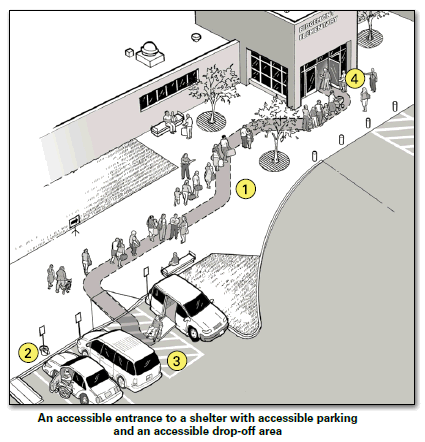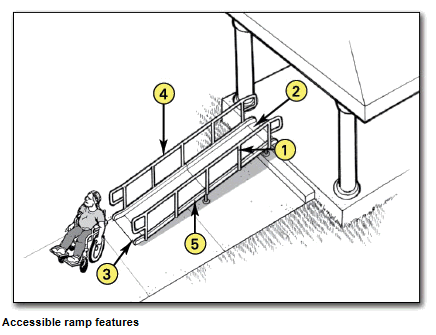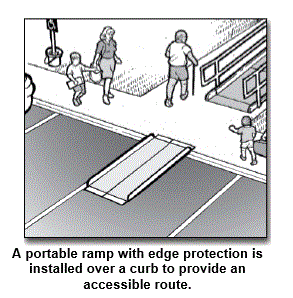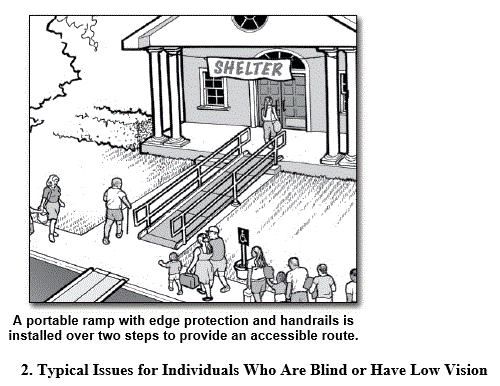1. Typical Issues for Individuals Who Use Wheelchairs, Scooters, or other Mobility Devices
An accessible route connects accessible passenger drop-off areas, accessible parking spaces, and other accessible elements, like a route from a bus stop, to an accessible building entrance. The accessible route is essential for people who have difficulty walking or who use wheelchairs or other mobility aids to get to the accessible entrance of the shelter. The accessible route must be at least 36 inches wide (it may narrow briefly to 32 inches wide where utility poles, signs, etc. are located along the accessible route). Abrupt level changes, steps, or steep running or cross slopes cannot be part of an accessible route. Where ramps are used, they cannot be steeper than 1:12. Ramps with a vertical rise of more than 6 inches must have handrails on both sides. Ramps must also have edge protection to stop wheelchairs from falling off the sides, and level landings at the top and bottom of each segment and where the ramp changes direction.

Notes:
1. Accessible route
2. Accessible drop-off area
3. Accessible parking with van-accessible parking space
4. Accessible entrance to shelter
C1-a. Is an accessible route provided from accessible parking spaces to the accessible entrance of the shelter? [ADA Standards § 4.1.2(1), 4.3]
Yes
No
C1-b. Is an accessible route provided from public sidewalks and public transportation stops on the shelter site (if provided) to the accessible entrance for the shelter? [ADA Standards § 4.1.2(1)]
Yes
No
Note: The accessible route is at least 36 inches wide and may be a portion of a sidewalk.
C1-c. Is the accessible route at least 36 inches wide? [ADA Standards § 4.3.3]
Yes
No
If No, does the accessible route narrow to 32 inches for no more than 2 feet?
C1-d. Is the accessible route free of steps and abrupt level changes higher than 1/2 inch? [ADA Standards § 4.3.8]
Yes
No
Note: Level changes between 1/4 inch and 1/2 inch should be beveled (sloped) at 1:2 maximum.
C1-e. Where an accessible route crosses a curb, is a curb ramp provided? [ADA Standards § 4.3.8]
Yes
No
e-i. Is the curb ramp surface at least 36 inches wide, excluding flared sides? [ADA Standards § 4.7.3]
Yes
No
e-ii. Is the running slope (up or down the ramp) no more than 1:12? [ADA Standards § 4.7.2]
Yes
No
Note: 1:12 is one inch of vertical height for 12 inches of horizontal distance.
C1-f. If the slope of part of the accessible route is more than 1:20, does it meet the following requirements for an accessible ramp?
Yes
No
f-i. Is the running slope no greater than 1:12? [ADA Standards § 4.8.2]
Yes
No
Note: For existing ramps, the slope may be 1:10 for a 6-inch rise and 1:8 for a 3-inch rise in special circumstances (see ADA Standards § 4.1.6(3)).
f-ii. Are handrails installed on both sides of each ramp segment? [ADA Standards § 4.8.5]
Yes
No
f-iii. Is the ramp width, measured between the handrails, at least 36 inches? [ADA Standards § 4.8.3]
Yes
No
f-iv. Does the ramp have a level landing at the top and bottom of each ramp section that is at least 60 inches long? [ADA Standards § 4.8.4]
Yes
No
Note: The level landing may be part of the sidewalk or walking surface.

Notes:
1. At least 36 inches between handrails
2. Top landing part of walk
3. Bottom landing part of walk
4. Handrail height 34 to 38 inches
5. Edge protection.
f-v. If a ramp is more than 30 feet long, is a level landing at least 60 inches long provided at every 30 feet of horizontal length? [ADA Standards § 4.8.4]
Yes
No
Note: if the running slope is less than 1:16 but more than 1:20, each ramp segment may be up to 40 feet long followed by a level landing].
f-vi. Is there a level landing, at least 60 inches x 60 inches, when a ramp changes direction? [ADA Standards § 4.8.4]
Yes
No
f-vii. Are the handrails mounted 34 to 38 inches above the ramp surface? [ADA Standards § 4.8.5]
Yes
No
f-viii. If the ramp or landing has a vertical drop-off on either side, is edge protection provided? [ADA Standards § 4.8.7]
Yes
No
Temporary Solutions For Emergency Sheltering - Ramps
Problem: The sidewalk connecting parking to the shelter entrance is too steep to be accessible.
Suggestion: Check to see if there is another accessible route to the accessible entrance. Sometimes there is a less direct route that is accessible. During an evacuation it will be helpful to put up signs or to have volunteers stationed at the accessible parking spaces to direct people along this less direct, but nonetheless accessible, route.
Problem: The accessible route crosses a curb but no curb ramp is provided.
Suggestion: Install a portable ramp with a slope no steeper than 1:12 with edge protection. Store the portable ramp on site so it can be easily accessed in an emergency.

Problem: There are two steps where the sidewalk connects to the accessible entrance.
Suggestion: Install a portable ramp with a slope no steeper than 1:12 with edge protection and handrails on both sides of the ramp. Store the portable ramp and components on site so everything can be easily accessed in an emergency.


User Comments/Questions
Add Comment/Question